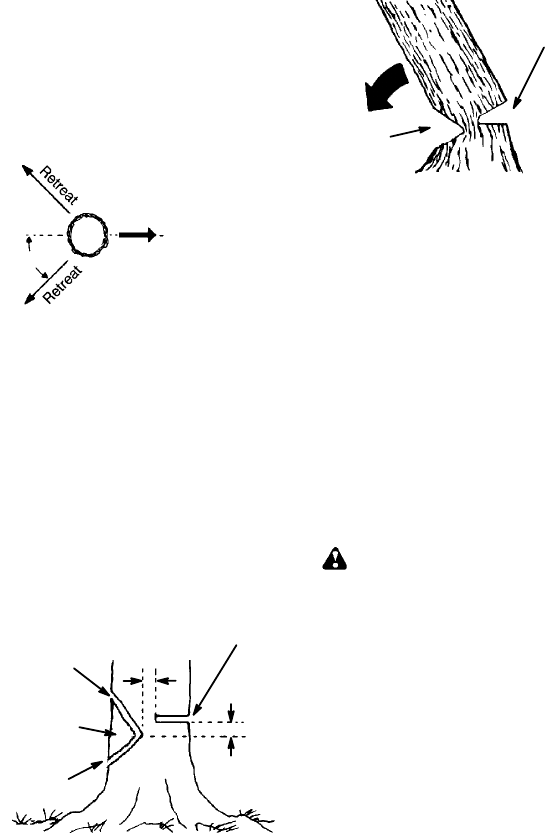
10
Natural conditions that can cause a tree to
fall in a particular direction include:
S The wind direction and speed.
S The lean of the tree. The lean of a tree
might not be apparent due to uneven or
sloping terrain. Use a plum b orlevel to de-
termine the direction of tree lea n.
S Weight and branches on one side.
S Surrounding trees and obstacles.
Look for decay and rot. If the trunk is rotted,
it can snap and fall toward the operator.
Check for broken or dead branches which
can fall on you while cutting.
Make sure there i s enough room for the tree to
fall. Maintain a di stance of
2-1/2 tree lengths
from the nearest person or other objects. En-
gine noise can drown out a warning call.
Remove dirt, stones, loose bark, nails, sta-
ples, and wire from thetree where cuts areto
be made.
Plan a clear retreat pat hto the rear and diag-
onal to the line of fall.
Direction of Fall
45_
Plan a clear retreat path
FELLING LARGE TREES
(6 inches in diameter or larger)
The not ch method is used to fell large trees.
A notch is cut on theside ofthe treein thede-
sired direction of fall. After a felling cut is
made on t he opposite side of tree, the tree
will tend to fall into the notch.
NOTE: If the tree has large buttress roots,
remove thembefore making the notch. If us-
ing saw to remove buttress roots, keep saw
chain from contacting ground toprevent dull-
ing of the chain.
NOTCH CUT AND F ELLING THE
TREE
S Make notch cut b y cutting the top of the
notch first. Cut through
1/3 of the diameter
ofthe tree. Nextcomplete thenotch bycut-
ting the bottom of the notch. See illustra-
tion. Once the notch is cut, remove the
notch of wood from the tree.
Notch
First cut
Second cut
Final cut here. 5 cm above
center of notch.
5cm
5cm
S After removing the wood from the notch,
make the felling cut on the opposite side of
the notch. This is done by making a cut about
two inches higher than the center of the
notch. This will leave enough uncut wood
between the felling cut and t he not ch to form
a h inge. This hinge will help prevent the tree
from falling in the wrong direction.
Opening
of felling
cut
Closing of
notch
Hinge holds tree on stump and helps
control fall
NOTE: Before felling cut is complete, use
wedges to open the cut when necessary to
controlthe directionof fall. Toavoidkickback
and chain damage, use wood or plastic
wedges, but never steel or iron wedges.
S Bealerttosignsthatthetreeisreadytofall:
cracking sounds, widening of the felling cut,
or movement in the upper branches.
S As tree starts t o fall, stop saw, put it down,
and get away quickly on your planned re-
treat path.
S DO NOT cut down a partially fallen tree
with your saw. Beextremely cautious with
partially fallen trees that may be poorly
supported. When a tree doesn’t fall com-
pletely,set thesaw asideand pu lldownthe
tree with a cable winch, block and tackle,
or tractor.
CUTTING A FALLEN TREE
(BUCKING)
Bucking is the term used for cutting a fallen
tree to the desired log size.
WARNING: Donot standon t helog
being cut. Any portion can roll causing loss
of f ooting and control. Do not stand downhill
of the log being cut.
IMPORTANT POINTS
S Cut only one log at a time.
S Cut shattered wood very carefully; sharp
pieces of wood could be f lung toward opera-
tor .
S Use a sawhorse to cut small logs. Never
allow another person to hold the log while
cutting and never hold thelog with your leg
or foot.
S Do not cut in an area where logs, limbs,
and roots are tangled such as in a blown
down area. Drag the logs int oa clear area
before cutting by pulling out exposed and
cleared logs first.
